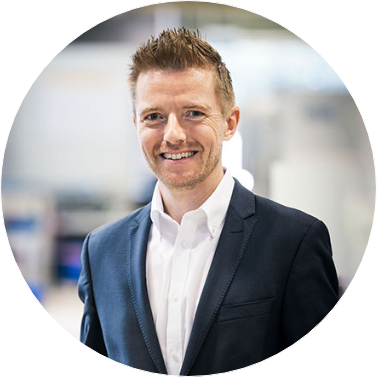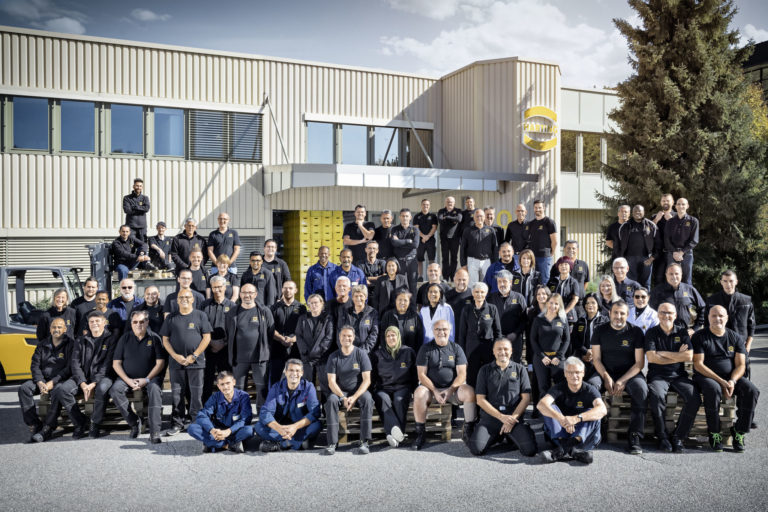




Tom Hess
Head of PM, Product &
Technology Development
Francois Roncoroni
Market & Product Manager
Hollie Finnegan
Inside Sales Technical
Claudio Sonzogni
Product & Application Manager
Stephan Schmidt
MID Sales North America

In general, MID technology processes do not differ from conventional plastics engineering. In order to ensure high quality, it is essential to prepare materials accordingly, take account of production-related effects and adapt further processing following the injection moulding process.
Thanks to our extensive experience with products from a wide range of sectors and industries, we are prepared for all eventualities as part of our in-house production chain.


In the LPKF-LDS® additive process, structuring is achieved by means of a laser beam which exposes and activates special additives in the plastic.
The infrared laser light forms a microrough surface in irradiated areas with metal particles and microcavities. The metal particles are altered by the laser energy in such a way that they act as a catalyst in the following metallisation step and result in selective metal deposition. The roughness provides optimum adhesion for the conductive tracks.

3D-MID metallises by building tracks additively as thermoplastic materials cannot be metallised directly using galvanic processes due to their insulating properties.
For this purpose, HARTING has built one of the largest, most modern metallisation plants especially for 3D-MID in Biel in Switzerland’s Seeland region. Besides the standard copper-nickel-gold layer system, this plant offers various extension options for other finished surfaces and is specially attuned to the requirements of the 3D-MID processes of laser direct structuring and two-component injection moulding. Depending on the size and geometry, the metallisation takes place in a barrel or frame.

HARTING has qualified various connection technologies at hand such as SMD placement, chip assembly, the combination of MID and PCBs or MID and connectors. These capabilities expand your MID component to form a complete sub-assembly.
The choice of connection technology depends on product design. Joining forces with you, we will decide which solution suits your product.
SMD (surface-mounted device) placement utilises soldering or conductive adhesives.
The technique preferred for MID is vapour phase soldering. This achieves homogeneous temperature distribution across the module, also with three-dimensional geometries.
We use conductive adhesives as an alternative connection technology. In particular, it is used as an alternative for materials unsuitable for soldering or when the assembly sequence makes the respective demands.

Working as partners on equal footing, we will take on your challenge and bring your idea to fruition – from the production-ready development of the substrates via the early creation of prototypes and on to final series production and qualification of 3D-MID packages – and all this 100% in house.
At every step of the process, you will benefit from our many years of experience, broad technology portfolio and test and inspection solutions proven in mass production.
You are currently viewing a placeholder content from YouTube. To access the actual content, click the button below. Please note that doing so will share data with third-party providers.
More InformationHARTING supports the process of realising 3D-MID technology by offering extensive options for the production of samples. Prototyping ranges from view models to fully functional sub-assemblies.
This allows us to illustrate the progress of development from an early stage and facilitate initial tests and trials. In this way, the development steps can be jointly planned with greater precision, thereby shortening the implementation time from the idea to the product.
With its tried and tested mass production procedures and technologies, two-component injection moulding and laser direct structuring, HARTING offers you a dedicated technology portfolio delivering high output rates.
By integrating the entire process chain under one roof and thanks to our extensive experience, we are able to offer you multiple benefits: from high-quality deliveries from a single source, short throughput times and outstanding flexibility in line with today’s market requirements.
We test and qualify materials, processes and your products under accredited conditions.
Drawing on our many years of in-depth experience, we have developed our own design and testing criteria. We are ISO 14001 and IATF 16949 : 2016 certified.
We carry out functional tests before delivery on the basis of quality characteristics defined in conjunction with our customers.
HARTING 3D-Circuits collaborated with Altium to create a 3D tool which brings circuit layout designing into a third dimension.
3D-MID technology combines electrical circuits with three-dimensional mechanical parts. This fusion of functionality opens up a world of possibilities within a vast range of application areas, and is now supported for the first time with Altium Designer’s new 3D-MID tool.
With Altium Designer you can create a layout on the surface of a 3D substrate using your standard library components and with the connectivity driven by your schematic design in the same way as with a standard PCB.






Tom Hess
Head of PM, Product &
Technology Development
Francois Roncoroni
Market & Product Manager
Hollie Finnegan
Inside Sales Technical
Claudio Sonzogni
Product & Application Manager
Stephan Schmidt
MID Sales North America

Just register for our Newsletter
FREE DOWNLOAD
Bitte tragen Sie hier Ihre E-Mail Adresse ein, wir senden Ihnen umgehend einen Downloadlink zu.
You need to load content from reCAPTCHA to submit the form. Please note that doing so will share data with third-party providers.
More InformationYou need to load content from reCAPTCHA to submit the form. Please note that doing so will share data with third-party providers.
More InformationYou are currently viewing a placeholder content from Google Maps. To access the actual content, click the button below. Please note that doing so will share data with third-party providers.
More InformationYou are currently viewing a placeholder content from Google Maps. To access the actual content, click the button below. Please note that doing so will share data with third-party providers.
More InformationYou are currently viewing a placeholder content from Mapbox. To access the actual content, click the button below. Please note that doing so will share data with third-party providers.
More InformationYou are currently viewing a placeholder content from OpenStreetMap. To access the actual content, click the button below. Please note that doing so will share data with third-party providers.
More Information